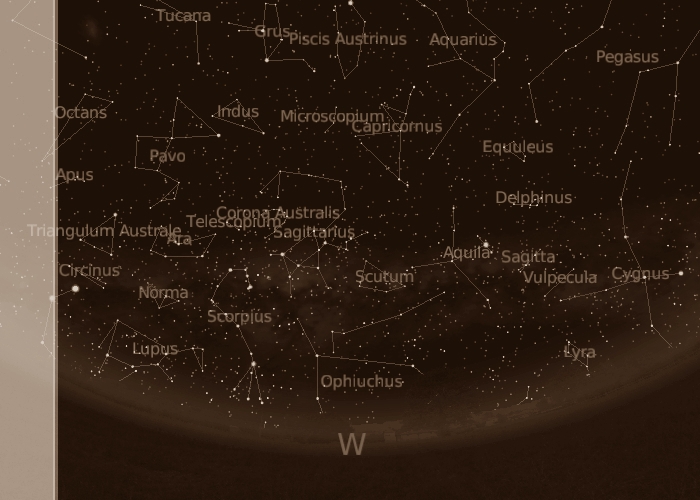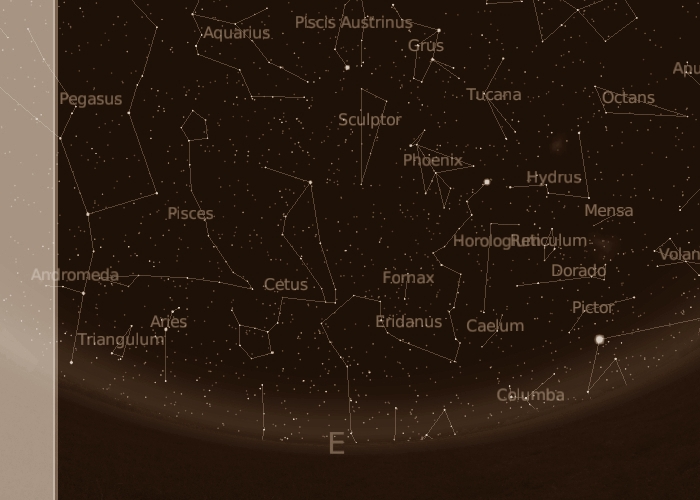Western Horizon
Eastern Horizon
->You will note that our site is passing DST for the southern hemisphere this month. more details
![]()
Western Horizon
Eastern Horizon

We are in spring now! As the show in spring, in the southern hemisphere, is to be seen East and North, some fine sights are to be seen West however. As the Pointers are now low southwest, the upper parts of Scorpion, the Scorpion, or Sagittarius, the Archer, with the center of our Milky Way Galaxy are fine sights which are keeping further, northwest, with Aquila, the Eagle, or Cygnus, the Swan, albeit the latter is low. The center of the Milky Way Galaxy, in Sagittarius is there where the bulge of old, yellowish stars is seen, along with the supermassive galactic black hole, of the size of the orbit of Mercury, which is lurking there. Nothing, even light, can walk out of that black hole, this place of intense density! Astronomers now think that every galaxy in the Universe is holding a black hole in its center. A row higher in the sky, such constellation like Pavo, the Peacok, with the bright star of the same name, the faint Microscopium, the Microscope, or Capricornus, the Goat are seen. South, the vast band of typically southern, Milky Way-embedded constellations is getting ready to lie just over the horizon. High, other typically southern constellations are seen as both the Magellanic Clouds are fine sights further. The brightest star in the region is Achernar, a blue star, 5 times the size of the Sun. to a printer-friendly chart
West for the tropics. West for the mid-northern latitudes

East, first see how Eridanus, the River Eridanus -this celestial river- is meandering a long way to Achernar. A fine sight. Cetus, the Whale is anchoring along the first bent of it. Cetus is home to the star Mira, a long-cycle variable star the luminosity of which is varying along several months. Mira, on the chart, is the brightest star which is seen just left of where Cetus is anchoring to Eridanus. The sequel to the typically southern constellations seen South, are seen southeast. See Horologium, the Clock, or Caelum, the Chisel. The bright star you could catch, low, there, is Canopus. As the faint chain of Pisces, the Fishes, with the asterism of the Circlet, is seen northeast, with Aries, the Ram, low below, let's move, eventually, to the northern horizon. It's now the best time for the Great Square of Pegasus and Andromeda, Andromeda. The Great Square of Pegasus is a square of four stars, a much fine sight, and easy to spot. The other spot of interest now, North, is the famed M13, the Andromeda Galaxy which is not still to its best. M13, the grey oval on the chart, is a large, fine, spiral galaxy, akin to our own Milky Way Galaxy, as it's providing a fine sight of how our own Milky Way would look, could we seen it from the outside. M13 is a fine binocular object. The leftmost parts of Pegasus are of interest too as they are sided by such small fine constellations which are seen in the vicinity of the Summer Triangle, like Equuleus, the Little Horse, or Delphinus, the Dolphin. to a printer-friendly chart
East for the tropics. East for the mid-northern latitudes
(color maps with Stellarium; printer-friendly charts with Cartes du Ciel, Patrick Chevalley)
Website Manager: G. Guichard, site 'Amateur Astronomy,' http://stars5.6te.net. Page Editor: G. Guichard. last edited: 12/28/2010. contact us at ggwebsites@outlook.com